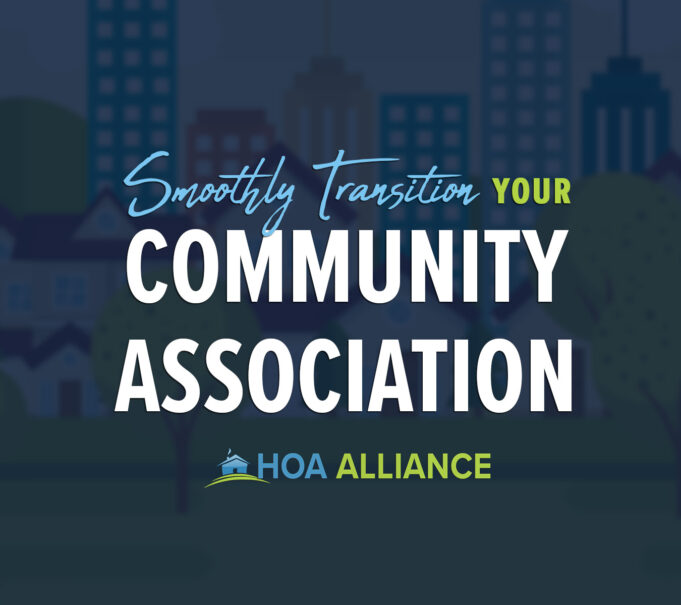Written By Georgia HOA Alliance
The following serves as a transition checklist of items the homeowner’s community association Board of Directors need to determine the existence and location of all relevant artifacts while transitioning from the existing management company of an Association to the Board of Directors or other management companies. This list is not exhaustive but serves as a checklist to assist community associations with a final transition.
Note: In some cases, the management company has been the ONLY custodian of a community association’s books and records; there is an expectation that the management company would have all requested documents dating back to the inception of the Association. Verifying the state law requirements for maintaining community association records is essential.
Community associations, such as homeowners associations (HOAs), may eventually transition from the management of a developer to a homeowners’ elected Board of Directors or another management company. When this transition occurs, it is essential to ensure that all critical documents and information are correctly transferred and all relevant details are accounted for.
A Community Transition Checklist serves as a guide to assist the Board of Directors to determine the existence and location of essential items during this transitional period. Below are some details that should be included in a Community Transition Checklist.
I. Introduction The introduction section of the checklist should provide some context for the document, explaining its purpose and scope. This section should emphasize the importance of a thorough transition process to ensure clarity and a smooth handover of responsibilities.
II. Governing Documents The governing documents section of the checklist should include a list of the critical documents that the Board of Directors will need to obtain to manage the community effectively. These documents may include the following:
-Articles of Incorporation
-Declaration of Covenants, Conditions, and Restrictions (CC&Rs)
-Bylaws
-Rules and Regulations
-Amendments to the CC&Rs, Bylaws, and Rules and Regulations
-Meeting minutes
-Voting records
-Financial statements
-Insurance policies
-Tax returns
The Board of Directors should review these documents carefully to ensure they are up-to-date and make any necessary updates or changes promptly.
III. Financial Information The financial information section of the checklist should include a list of financial documents and information that the Board of Directors should review carefully, such as:
-Budgets (past and present)
-Audited financial statements
-Reserve study and schedule
-Delinquency reports
-Payment records (accounts payable and accounts receivable)
-Bank statements
-Tax returns
-Investment policies and strategies
The Board of Directors should ensure that all financial information is accurate and up-to-date and that any necessary monetary policies or procedures are implemented to manage the community’s finances effectively.
IV. Insurance Information The insurance information section of the checklist should include a list of insurance policies that the Board of Directors should review, such as:
-Property insurance (including common areas and individual units)
-Liability insurance
-Director and officer (D&O) insurance
-Workers’ compensation insurance
-Fidelity bond insurance
The Board of Directors should ensure that all insurance policies are up-to-date and provide adequate coverage for the community. They should also review any claims history to identify potential risks or issues that need addressing.
V. Physical Assets The physical assets section of the checklist should include a list of community assets and their maintenance and repair schedules, such as:
-Standard area amenities (pools, playgrounds, parks, and others.)
-Landscaping and irrigation systems
-Parking lots and roadways
-Roofing and exterior building materials
-HVAC systems
-Elevators and other mechanical systems
The Board of Directors should ensure that all physical assets are well-maintained and in good working order. They should review maintenance or repair schedules to identify any issues or necessary repairs.
VI. Communication and Administration The communication and administration section of the checklist should include a list of communication and administrative items that the Board of Directors should review, such as:
-Contact information for residents, vendors, and service providers
-Meeting minutes and agendas
-Board member and committee member information
-Community policies and procedures
-Community newsletter or website
The Board of Directors should ensure that all communication and administrative systems function correctly and that any necessary updates or changes are made promptly.
VII. Conclusion, The conclusion section of the checklist should summarize the essential items covered in the document and emphasize the importance of conducting a thorough transition process. A new homeowners’ Board of Directors is disadvantaged without proper training and continuing education. Get some!
I. Introduction
Explanation of the purpose of the checklist
Note about Management Companies being the only custodian of the Association’s books and records
II. General/Operational Items
List of items needed to be determined by the Board of Directors
The expectation of the Management company having all requested documents dating back to the inception of the Association
Sub-list of required items:
All association books or records held by or controlled by the John Wieland and NMA
An accounting of association funds and financial statements
All Past/Current association insurance policies
Complete Past/Current roster of homeowners and their addresses
Any contracts Past/Current in which the Association is a contracting party
III. Warranty/Physical Facilities Items
List of items needed to be determined by the Board of Directors
Sub-list of required things: 6. Complete set of site plans and as-built drawings
Written warranties of the contractors, subcontractors, suppliers, and manufacturers
List of manufacturers of products and specifications used in the maintenance, repair, or replacements
Copies of any bonds or letters of credit posted with any state or local agency
Schedule of quantities of specific areas of the association property
Confirmation of compliance with the local authorities
Completion bonds, either in place or already released
Traffic and safety regulatory signage
Fire code compliance
Designation of roadways and site lighting, both public and private
IV. Conclusion
Note that the checklist is not exhaustive but serves as a guide.
This a reminder that the Board of Directors should ensure a final transition from a management company.
Shared from Georgia HOA Alliance











